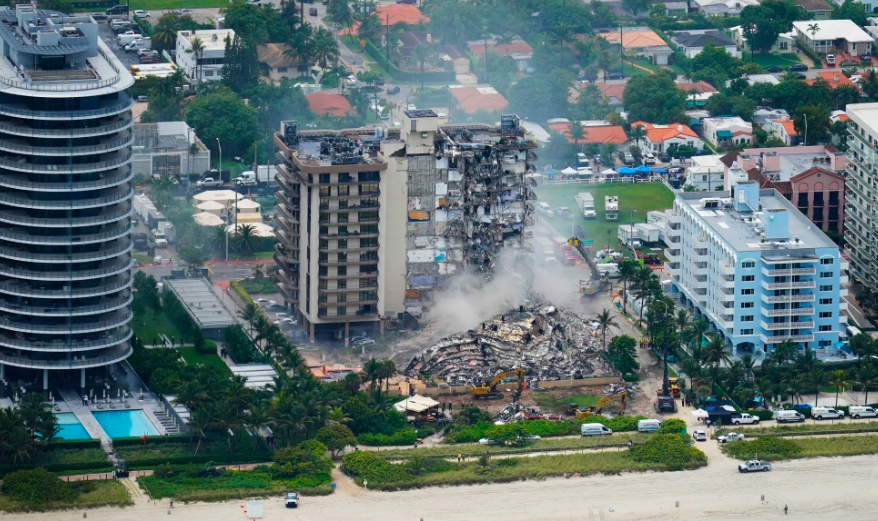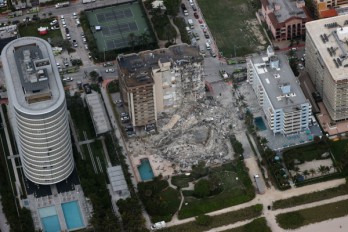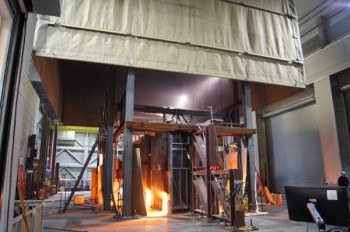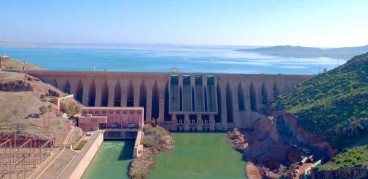Pool Deck Initiation and Progressive Collapse Path on the Surfside, Florida, Condo Building

Federal investigators report that the 2021 partial collapse of Champlain Towers South in Surfside likely initiated in the pool deck rather than the tower superstructure. Based on large-scale structural testing, computer analyses, and timeline reconstruction, the National Institute of Standards and Technology indicated that failure most likely began at a slab-to-column connection on the pool deck and then propagated into the middle and east portions of the tower. Indicators of localized distress were documented in the weeks before the event, including a sliding glass door that came off its frame, a horizontal crack in a planter wall, a shifted gate, and reports of water leaking from the garage ceiling that intensified the day prior. The pool and street-level decks began to fail at least several minutes before global collapse at 1:22 a.m. on June 24, 2021. The investigation remains active, with final determinations expected following completion of technical reports.
Preliminary analysis cited low safety margins in the pool deck slab-column connections attributed to design under-strength and misplaced slab reinforcement. These conditions reduced robustness against progressive collapse once a local failure occurred. For civil and structural practice, the case underscores the value of verifying slab-column detailing, assessing ponding and waterproofing performance, and monitoring interfaces between exposed plaza slabs and occupied spaces below. Attention to drainage, corrosion protection, and redundancy can limit damage propagation. Documented pre-event symptoms also illustrate how facility observations, captured through routine inspections and resident reports, feed into timely mitigation.

Evolving Regulatory Context
Following the collapse, Florida enacted measures requiring condominium associations to maintain reserves for major repair scopes and to complete structural integrity studies on defined timelines. Subsequent legislation permits the use of loans or lines of credit to fund reserves, allows temporary adjustments to reserve contributions while critical repairs proceed, extends certain study deadlines, and exempts some smaller buildings from specific study provisions. These changes align capital planning with inspection findings and are intended to reduce deferral of essential work.
Here you can find all the forensics investigations and the latest discussion done from NIST.
Following is a video discussing the latest finding on the tragic incidence.
Sources: nist.gov, cbs12.com, nbcnews.com
Want to read more like this story?

Florida collapsed condo’s pool deck failed to comply with building codes and standards, officials say
Jun, 15, 2023 | NewsA preliminary summary of findings regarding Florida’s Surfside condominium collapse was issued on T...

Multistory building collapse in Miami
Jun, 25, 2021 | NewsAt least 1 person has been reported dead after a multistory building collapsed in Surfside, Miami, F...

Myanmar’s Earthquake to Bangkok’s Collapse: Anatomy of a Skyscraper Disaster
Mar, 28, 2025 | NewsIn the wake of a powerful 7.7 magnitude earthquake centered nearly 1,000 kilometers away in Myanmar...

Study on the impact of fires in high-rise buildings
Apr, 21, 2020 | NewsResearchers from the U.S. National Institute of Standards and Technology (NIST), conducted a thoroug...

Bangkok 30 storey Audit Office Collapse Attributed to Construction Defects
Jul, 02, 2025 | NewsOn March 28, 2025, a 7.7-magnitude earthquake originating in central Myanmar caused the collapse of...
Building partially collapsed twice within 8 days in Welland, Canada
Mar, 09, 2023 | NewsA five-story, 226-unit condo suffered partial collapse twice within 8 days. More specifically, the...

Burj Khalifa Opens New Observation Deck
Oct, 17, 2014 | NewsVisitors to the Burj Khalifa in Dubai can now pay to ride to the 148th floor to get an even more ele...

Rescue and Reflection: Structural Collapse at Kannauj Railway Station
Jan, 11, 2025 | NewsA tragic structural collapse at the under-construction terminal of Kannauj Railway Station in Uttar...

7-story building partially collapses in New York
Dec, 11, 2023 | NewsA seven-story building partially collapsed in the Bronx of New York, on the afternoon of Monday, De...
Trending

Vertical gardens in Mexico City to combat pollution

Characteristics of Load Bearing Masonry Construction

Taipei 101’s impressive tuned mass damper

Morocco Implements Landmark Dam Perforation to Combat Water Stress in Marrakech

Dutch greenhouses have revolutionized modern farming

The Line at Neom faces feasibility reassessment while construction continues

A new chapter for Sunderland: The £31 million Keel Crossing opens

